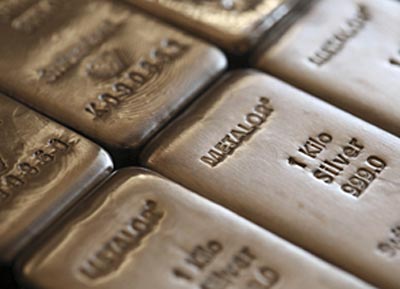13
2013
February 13 2013 |
What's next for silver? 
It's very easy to get sucked into the silver story. It's very seductive. Indeed, a recent Thunder Road report by analyst Paul Mylchreest described silver as "(probably) the best asset in the world". Is he right? Should we all be piling into silver? The bull case for silverLet me start by outlining what is seen by many as the irresistible, slam-dunk case for investing in silver. Like gold, silver is – or was – a monetary metal. So its attraction is clear in these times of monetary intervention and currency debasement. (In some 90 or more different languages the words silver and money are interchange-able: argent in French, plata in Spanish, shekel in Hebrew, for example. The pound once meant a pound weight of sterling silver.) Also, unlike gold, silver has many industrial uses. It has good electrical and thermal conductivity, it is sensitive to light and reflects it well, and it can endure extreme ranges of temperature. That makes it useful in products from computers and phones to batteries and plastics (as a catalyst). It's used in industries ranging from jewellery manufacturing to nanotechnology, and even in medicine, because of its anti-bacterial properties. In 2010, according to the Silver Institute, 487.4 million ounces of silver were used in industry, 167 million ounces in jewellery, and 101.3 million ounces in coins and medals. Unlike gold, however, which gets hoarded, most of the silver used by industry is consumed. From an investment point of view, the hope is that this means more will need to be mined. Given that existing mine supply doesn't meet demand, this should drive prices higher. In 2011, world silver production stood at 23,688 tonnes. Demand, however, stood at 32,366 tonnes – meaning there was a deficit of 8,678 tonnes. This deficit is about average for the last 20 years. Currently it is met by existing stock. Below, courtesy of Nick Laird of sharelynx.com, we see production, demand and deficit since 1950. And I have to admit that every time I look at the supply and demand numbers for silver, and at the increasing range of fabulous technologies it is getting used in, I just want to go out and buy as much as possible. Silver's key turning pointsBeware. It's very easy to get sucked into the silver story. And it has a habit of promising but not delivering. For all of the volatility that comes with silver, over the long-term it has a surprisingly well-behaved chart. There are several key price levels, as you can see on the chart below, which shows silver since 1980. At various points in silver's history these key levels have acted either as support or resistance.
At the bottom of the range we have numbers which will probably never concern us again. $3.50 is the all-time low, reached in 1991 and again in 1993. $3.50 for an ounce of silver! Amazing. It actually touched $4 as recently as 2001. It then meandered around the $5-$6 mark for many years. Then, in late 2003, things got exciting. The next key area is $8. It acted as resistance from 2004 to 2006, and then as a last line of support during the capitulation of 2008. $10 is my next line, and then, more importantly, $15. Like $8, it was a barrier for two years (2006-08). $15 is a number we may well see again in the event of some kind of capitulation or deflationary scare. The next line in the sand is $22 and then $26, which is particularly important now, in my view. This has marked the bottom of silver's range – strong support – since silver's run to $50 ended so painfully. It has been re-tested numerous times and held on every occasion. I'm watching that number closely now as it may well be that silver gets there again on this correction. If it does, one trade to consider is to buy around $26 with a stop 5-10% below. Finally, there is the big one: $50. This is the all-time high, touched in 1980 and retested unsuccessfully 31 years later in 2011. Trading off these levels – be it on the long or the short side – has been productive over the years. So what might happen next? On this next chart, which shows the last three years of silver, you can see the importance of that $26 area which I have drawn in red. Silver has been range-bound between $26 and $35 for over a year now and, sooner or later, it is going to make a break one way or the other. That's why I'm so concerned about $26. As long as that holds, we can keep thinking: "the bigger the base, the higher in space", as the saying goes. � There are many lines of resistance and support within this $26-$35 range. I've identified them with red dotted lines. Perhaps $30 will hold on this current downdraught. Another trade to consider is going long silver with a stop just below the $30 mark. For now we are stuck in the middle of the range, and the trend is down. But I wouldn't recommend shorting silver � not yet, at least. It's going to take a lot of buying to get back to the $50 mark of 2011. But if silver can get above $50, which I'm hoping it will in the next year or three, then it could really fly. I always keep some silver bullion to make sure I'm exposed when it finally does. How to buy silverYou can play silver in several different ways. You can buy the physical metal, though it is subject to VAT. I know one chap who gets round this by buying antique tea sets at below the value of their silver weight. Another way to avoid VAT is to buy metal through online dealers such as BullionVault, Goldmoney and Goldcore, and not take delivery. There are also exchange-traded funds that track the silver price (LSE:PHAG is one). If you're interested in the miners, the largest silver producer is BHP Billiton � hardly a pure play. Yet the large cap pure plays � Pan American Silver and Fresnillo � have underperformed the metal in recent years. So why bother taking on the individual company risk? However, some of the smaller producers have excelled. In particular, I like First Majestic (NYSE:AG; TSX:FR), which I tipped in my silver report a few years back. Its president, Keith Neumeyer, has taken the company from below $1 in late 2008 to $25 at one stage. It's now at $18. Neumeyer is growing the company all the time, more and more mines are coming into production, while further acquisitions are being made. Neumeyer has a proven record on delivery. If you want to consider other smaller producers, or companies with near-term production potential, I would take a look at Impact Silver (TSX:IPT) and Santa Cruz (TSX:SCZ), both of which trade on the Venture exchange in Canada. |
 |
 |
 |